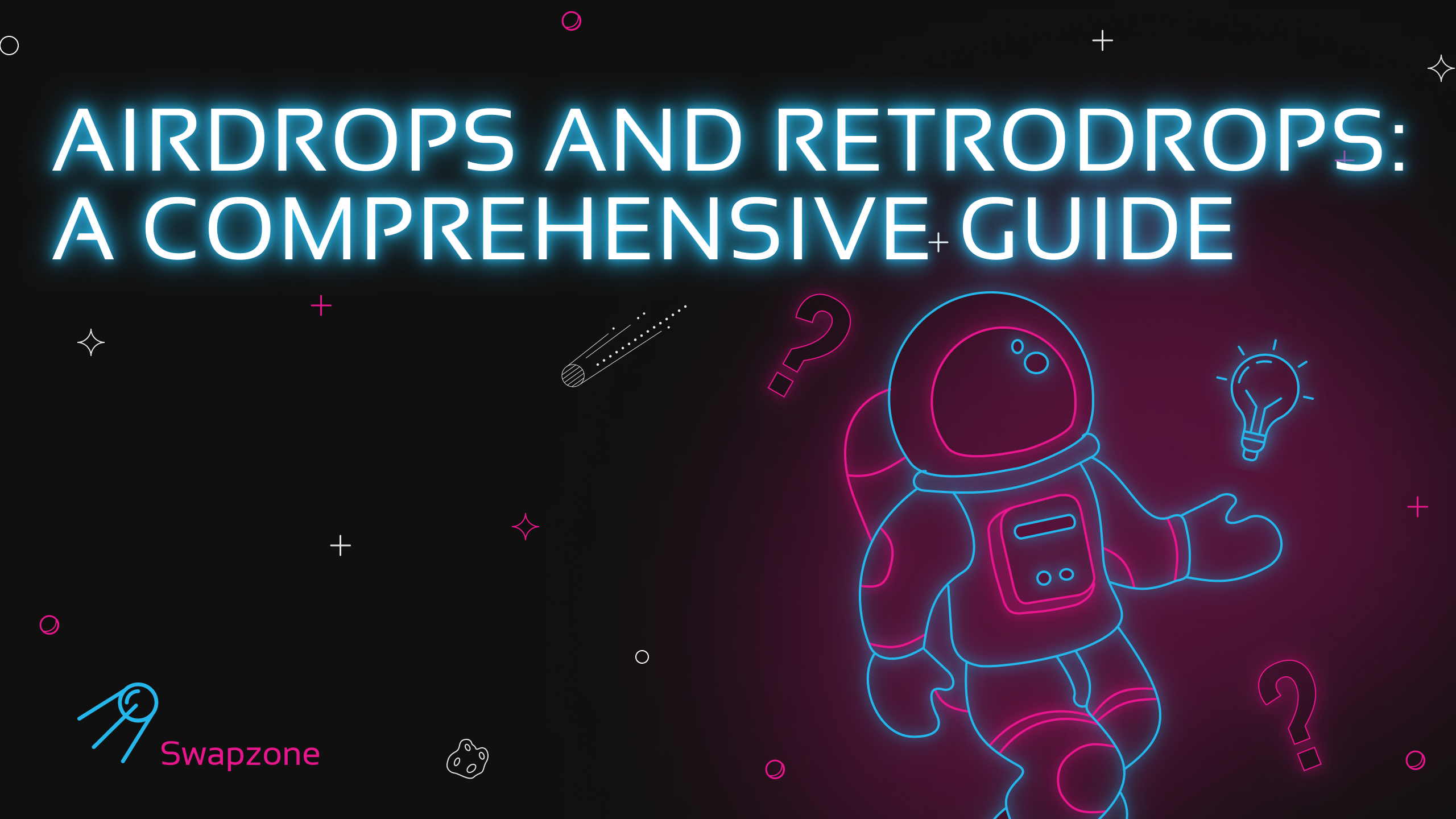It has been quite a few years since the world was introduced to the first cryptocurrency, Bitcoin. Back then, in 2009, people almost didn’t pay attention to blockchain technology, which today has become a popular trend all over the world. Today, more and more countries are emerging that legally accept cryptocurrencies as one of the means of payment.
The interesting thing is that the use of digital money is not limited to just buying, selling, and exchanging different coins. Actually, even new users can earn from cryptocurrency in different ways. One of the most popular and effective methods is the giveaways that are organized by the developers of a certain currency. You may have already heard from your acquaintances or seen comments in discussions on crypto forums that you can get valuable assets for simple actions. Yeah-yeah, this is really true, and any person can profit from the cryptocurrency. However, there are two types of giveaways for users – airdrops and retrodrops. This article will tell you more about what they are, what are the differences and similarities between these options and how to take advantage of them.
Airdrop – What Is It?
A cryptocurrency airdrop is defined as the distribution of newly launched tokens or coins for free to individuals and, most times, to existing crypto communities. This is a good strategy that allows a new cryptocurrency project to inform about the project and distribute tokens among potential users. Why are airdrops benefits?
Certainly, airdrops are very profitable for regular users because they give them a chance to get assets that can be later sold for fiat money on crypto exchange. Analyzing the potential consequences, it can be stated that those who participated in the airdrop before the launch can have a large profit in the course of the increased demand for the project after its launch. In simple terms, it means that users have all the benefits associated with an increase in the value of the coin while they have no downside risk whatsoever.
What about the benefit of the developers of this currency? Airdrops also help developers in enhancing the visibility of a new project in the market quickly and distribute tokens to other wallets. Tokens in the possession of people make it possible for the user to have an interest in the project and contribute to the network by staking, validation of transactions or by coming up with additional products to be interoperating with the network. In the general sense, it results in faster rates of growth within the community.
Types of Airdrops
Obviously, the end result of any airdrop is the distribution of internal tokens between users who have fulfilled certain conditions of the developer. However, what types of popular airdrops do you know? There are a few key ways airdrops are typically structured:
- Holder airdrops. These involve giving everyone an equal chance to receive tokens if they hold a particular existing cryptocurrency. For example, wallets possessing more than a certain amount of tokens might be entitled to a specific quantity of the new token airdropped.
- Holding activities. Here, the users are required to complete tasks such as sharing social posts or answering quiz questions regarding the project to be in a position to receive the token drops.
- Bounty programs. Users are required to report bugs, translate content, market the project, and do other activities to get tokens in return.
- Hard Fork. A hard fork is a major network upgrade that splits the blockchain into two blockchains: the original blockchain, which operates under the old rules, and a new blockchain, that complies with the new rules. As a result, two networks and two coins are created.
In general, the well-thought-out airdrops are the costless promotion of the cryptocurrency for developers who want to encourage the target group of potential consumers. The ordinary user becomes an active member of new networks as soon as possible without any financial risk at all.
Real Examples of Airdrops
Today, there are still skeptics who do not believe in the reality of running airdrops. However, over the past few years, many examples have been collected where users have received their rewards after completing an airdrop. The best examples of airdrops are gathered below.
1. Battle Infinity
A new blockchain game Battle Infinity attracted users by giving away $3,000 worth of IBAT tokens. To get them, users had to subscribe to the project’s accounts in various social networks. After the launch of the game, the tokens were placed on the PancakeSwap crypto exchange. IBAT is Battle Infinity’s service asset that can be used to earn money in the blockchain game.
2. BAT
BAT (Basic Attention Token) is created on the Ethereum blockchain and runs on the Brave web browser. The goal of the project is to estimate how much time visitors spend browsing a certain media resource. To participate in promotional giveaways, you need to download the Brave browser and enable the Brave Rewards feature. You can get rewards for completing tasks (watching videos, answering questions) in the form of free tokens once every 30 days on a first-come, first-served basis.
3. PulseChain
PulseChain is a fork of the Ethereum network. Anyone with ETH in their wallet can participate in its airdrop with free PLS token distribution. PLS are given out in the ratio of one-to-one to Ethereum. Within 30 days, the received tokens must be transferred to a new wallet in the PulseChain network. Failure to do so will result in the burning of the free cryptocurrency.
4. DeFiChain
The decentralized blockchain DeFiChain promises to increase efficiency, intelligence, and transparency in services by leveraging the power of Bitcoin’s DeFi ecosystem. Using the platform, crypto investors can generate staking revenue and borrow. DeFiChain is giving away $30 worth of free DFI tokens to new users.
5. Tidex
Tidex is a British crypto exchange with the TDX native token. The platform holds an airdrop with a prize pool of 20 million TDX. Each participant in the giveaway can get up to 200 tokens by completing basic tasks. For example, you need to register an account on Tidex, go through the verification procedure, and deposit $20 worth of cryptocurrency into your account.
Retrodrop – What Is It?
Retrodrops represent a new concept in the cryptocurrency world and can be used by projects to airdrop tokens to those who have contributed in the past or used the service. While airdrops are aimed at attracting ordinary users who are waiting for rewards, retrodrops are created for active participants. In fact, their principle of operation is quite similar. The only difference is that rewards in retrodrops are given after performing certain actions. It is not about subscribing to the official cryptocurrency channel or writing comments under the posts of developers.
Members must be actively involved with cryptocurrency, including exchanging, selling, buying and more, in order to take part in retrodrops. That is why, unlike airdrops, participating in retrodrops may require users to make small investments. However, the terms will vary depending on the project that has announced the retrodrop to users.
Retrodrop involves the process of distributing tokens of cryptocurrencies to wallets that have been previously involved with a particular protocol. For instance, if a DeFi protocol has been in existence for one year, it can cause a retrodrop and launch tokens to all the wallet addresses that employed the protocol within the first year.
What about a working principle of crypto retrodrops? All the retrodrops use a basic operation mechanism. The project goes through the blocks, such as the wallet addresses that used the protocol prior to the token generation event. From this, depending on some parameters, they determine the amount of reward to be granted per address for the previous period. Last but not least, they send the created tokens back to these addresses based on the mining method.
Real Examples of Retrodrops
It’s not hard to understand the difference between airdrops and retrodrops in cryptocurrency. However, the best way to deeply explore this topic is to look at real-life examples of retrodrops that have allowed users to earn valuable rewards for their activity.
1. Tamadoge Air
The blockchain game platform Tamadoge gave away $100,000 worth of TAMA tokens. Participants of this retrodrop had to complete nine tasks. For example, subscribe to the project’s Instagram account, join Discord, write in X (ex Twitter) about @Tamadogecoin, tagging Elon Musk, etc. Another requirement for participating in the giveaway is to own at least $100 worth of TAMA.
2. Lucky Block
Lucky Block is a blockchain system for holding crypto and NFT tournaments in the BSC network. The entire project here is managed by smart contracts, which guarantees players security and privacy. Retrosprops take place at Lucky Block throughout the year. In order not to miss the opportunity to get free tokens, you need to register on the site and buy an NFT entry ticket for $5.
3. StarkNet
Another crypto retrodrop is StarkNet – a permissionless decentralized rollup designed to bring scalability to Ethereum, which made a notable retroactive airdrop in 2023. The users engaging actively with the dApps in the StarkNet were rewarded with an airdrop of over $130 million worth of STRK crypto tokens. This surprise giveaway was for early adopters and dApp builders who had a trading volume of at least 100 USDT on StarkNet when it was still in the beta stage.
4. Dymension
Dymension is a cutting-edge blockchain technology company that has built digital worlds and metaverses in recent years. Developers held retrodrop 1.5 million tokens for early backers. There were incentives given to community members who demonstrated high engagement in using the products, reporting bugs, sharing the application with others, and providing feedback. They were given over $500 worth of DYM crypto tokens. This retrodrop gave the committed users a good feeling and gave them something back.
5. Monad
This little-known decentralized platform recently surprised all cryptocurrency users with a major retrodrop. The platform decided to give away Wormhole (W) tokens in exchange for a set of completed tasks. Basically, users were required to be active and make a minimal investment, which pays for itself after the rewards are handed out. Such a kind of community reward and recognition in this type of decentralized ecosystem is a great ballast for future decentralized communities.
What to Choose for Earning – Airdrops or Retrodrops?
While an airdrop and a retrodrop are a kind of giveaway that provides a chance to get free crypto, they are different. An airdrop occurs when a project issues free coins or tokens to the members of the crypto community in a bid to create awareness of its existence and encourage usage. Retrodrops work more like a loyalty program. You get rewards after reaching a certain trading volume, as well as token purchase or NFT.
Which of these two options is better suited for a stable income? Actually, participating in airdrops can not guarantee getting prizes 100%. Meeting all the requirements just increases your chance of getting coins. As a rule, the coins obtained immediately after completing an airdrop are not worth much. However, if you keep them in your wallet for a while, they can grow in value several times. Retrodrops allow for a great return on your investment and the opportunity to earn new tokens. It’s hard to single out which type of giveaway is best for you. A great option is to regularly participate in both airdrops and retrodrops.
Final Thoughts
Obviously, no cryptocurrency developer guarantees that users will be able to become dollar millionaires after giving out rewards. However, today, it is well observed how this sphere is developing and how quickly the trend of holding such airdrops and retrodrops is growing. Moreover, many giveaways have started to be held in the form of mobile games, which are liked by many people. This will allow you to enjoy interesting gameplay, perform special tasks, and expect to get a share of the rewards budget.


